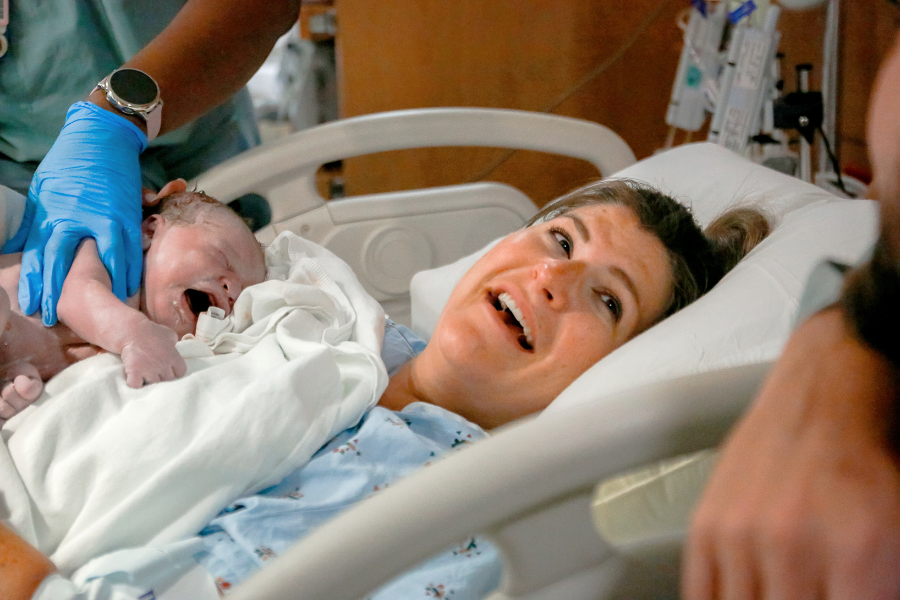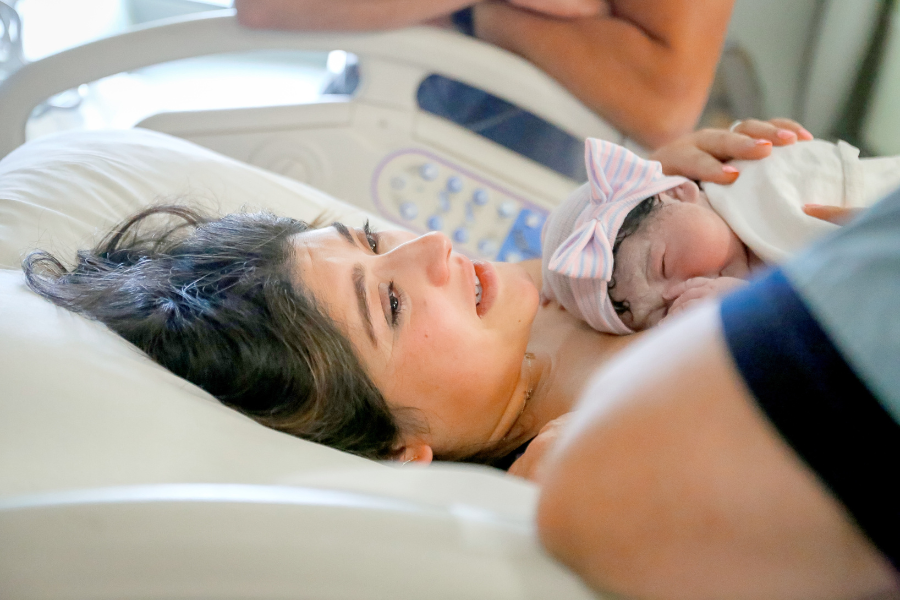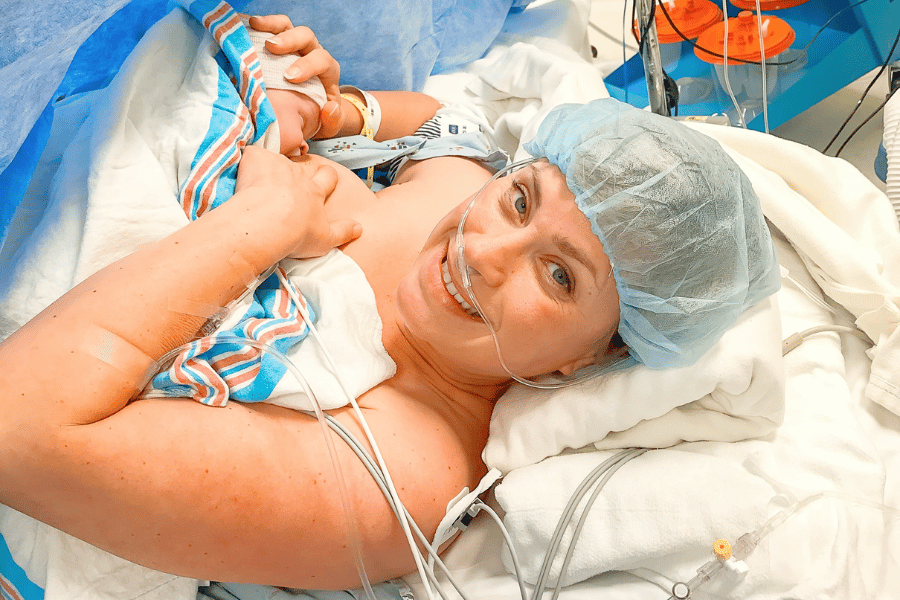How to prevent tearing during birth? I get this question in my Instagram DMs at least a dozen times every week! And I get it, the thought of tearing your vagina is kiiinda of terrifying – especially as a first-time mom.
The thing is that tearing during labor is actually really common. In fact, more than 4 out of 5 first-time moms will experience a tear during labor – but over 96% of those tears are very minor!
Take a deep breath, mama! I’m not saying that to scare you. My hope is that knowing just how common tearing is will help relieve some of your anxiety about it! I also want you to understand that even though it happens to most of us, most won’t experience any lasting complications.
But don’t think I’m going to leave you there! This article is titled how to prevent tearing during birth after all. And you’ll be excited to know that there actually are some things you can do!
I’ve taken a look at the research and gathered lots of anecdotal reports to help you learn how to prevent tearing. I also included a thorough overview of tears in general and talk about how to care for them after birth if it does wind up happening to you.
Ready to talk vaginal tears? Let’s do it.
Follow @mommy.labornurse on Instagram to join our community of over 650k for education, tips, and solidarity on all things pregnancy, birth, and postpartum!
Types and degrees of vaginal tears
Before we get to the prevention, I want you to understand what vaginal tears are all about. I think a lot of us hear the word tear, and we’re just like “What do you mean TEAR?!” So let’s unpack this a little bit.
Vaginal tears are scored on a scale of 1-4 degrees based on their severity. A 1st degree tear is the least invasive, and a 4th degree tear is the most invasive. I mentioned it in the intro but it bears repeating: only 2-4% of ALL tears during labor are 3rd or 4th degree tears. This means you have over a 96% chance of NOT tearing to your butthole. And that is a stat worth focusing on, hah!
Another journal article that studied over 38,000 singleton, vaginal births found that only .25% of women sustained a 3rd or 4th degree tear. So you see, the odds are seriously in your favor.
Here’s a little vaginal tear infographic I created that helps illustrate the four degrees, and below that, I’ll describe the characteristics of each.
View this post on Instagram
1st Degree Tear
- 1st degree tears are the least severe and involve only the perineal skin. The perineum is the area between the vaginal opening and the rectum. It includes the surface skin and the tissue directly beneath the skin
- A 1st degree tear is described as slight, minor, and superficial. Often, 1st degree tears do not even require a stitch
- If you have a 1st degree tear, you may experience some mild pain or stinging during urination. Typically, they heal on their own within a few weeks of birth
2nd Degree Tear
- These tears go a little deeper, into the perineal tissue and muscle underneath the perineal skin. These tears need to be stitched closed, layer by layer
- But the stitching is generally minor – one or two stitches is all it takes
- 2nd degree tears will cause you some discomfort like mild pain and stinging when urinating
- They usually heal within a few weeks of delivery
3rd Degree Tear
- A 3rd degree tear extends through the perineal muscles, and into your anal sphincter (but not completely through). Your anal sphincter is the muscle that surrounds your butthole and controls your bowel movements
- 3rd degree tears are more serious, but they can usually be stitched up in the delivery room right after you give birth
- In some cases, you may need to go to the OR and have a 3rd degree tear stitched up with anesthesia
- Just like with a 2nd degree tear, it needs to be stitched layer by layer, but because the tearing is deeper and more extensive, healing can take longer than a few weeks
- 3rd degree tears do come with possible complications including leaking stool and painful intercourse (even once you’re cleared at 6 weeks postpartum)
4th Degree Tear
- This type of tear extends completely through to the anal canal or rectum, and will most likely have to be repaired by your provider in a procedural room or the OR
- Some providers do stitch 4th degree tears in the delivery room, so be aware of that as a possibility!
- 4th degree tears sometimes require specialized repair, depending on how deep and extensive the tear is
- 4th degree tears often come with complications such as fecal incontinence and painful intercourse
- Healing from a 4th degree tear will take longer than a few weeks, but the timeline is often unique for each mama
What happens if I experience a more severe tear during labor?
If you experience a 3rd or 4th-degree tear, the repair will be a bit more extensive. Like I mentioned above, it’s possible that your provider will stitch you up right in the delivery room after giving birth, but they also might have you go to the OR or another procedural room to repair you with anesthesia.
Usually, mamas who experience a 3rd or 4th degree tear are given a dose of antibiotics after delivery to help prevent any sort of infection from developing. This is because these tears are a little deeper and have a higher likelihood of becoming infected.
Healing will take a bit longer, and we’ll want to check on you
With a more serious tear, your provider will want to see you back in the office a few weeks after delivery to make sure things are healing smoothly. This will be sooner than the typical 6-week postpartum check-up.
Between your birth and that check-up do not hesitate to call if you have any concerns about how your tear is healing. Be sure to ask about red flags and warning signs to look out for before you are discharged from the hospital so that you know when to call!
Oh! And it’s SUPER important to be taking stool softeners if you have either a 3rd or 4th-degree tear, you do not want to mess with this mama. Honestly, it’s important and recommended for any type of tear, but especially with more severe situations.
Let’s look at some vaginal tear risk factors
Your biggest risk for tearing is being a first-time mom. I’m sorry, I know that is an unavoidable risk, but again, I’m all about setting realistic expectations here!
First-time moms have about three times the risk of tearing than moms who have birthed vaginally before. In fact, if you are a first-time mom, you have about an 85% chance you’ll have SOME sort of tear but remember, it’s most likely going to be a 1st or 2nd degree tear.
A few other factors that increase your risk of tearing or having a more severe tear:
- Vacuum or forceps delivery
- Baby over 8.5 lbs
- Prolonged second stage of labor (the pushing stage)
- Asian ethnicity
- Occiput posterior positioned baby (sunny side up)
- Episiotomy (Once your provider cuts an episiotomy, the likelihood that you’ll continue to tear further into a 3rd or 4th increases)
- Large infant head circumference (well, duh)
- Having a shoulder dystocia
- Epidural use (this slightly increases the risk of a severe tear for a few different reasons; source)
(source)
7 ways to prevent tearing during birth
Okay, now that we’ve laid a thorough foundation about what tearing during labor is all about (and the fact that it’s actually SUPER common) let’s get into the prevention!
There is a good chance you may not be able to COMPLETELY 100% prevent tearing if you are giving birth for the first time. But what you can do is aim to prevent a more severe tear from happening!
Here’s the quick list of ways to prevent tearing during labor:
- A warm compress while pushing
- Perineal massage
- Sexual arousal during labor
- Train with an Epi-No
- Pushing positions
- Avoid an episiotomy
- Make sure you’re getting enough protein
But let’s dive into the details!
1. A warm compress as you are pushing
While you are pushing, ask your nurse or doula if they can assist you in applying heat to your perineum. This can simply be a washcloth that is soaked in warm water. It’s super easy, and this is one of the most effective ways you can decrease the possibility of tearing.
There’s actually a lot of research out there that proves just how effective a warm compress is at reducing the risk of tearing (or of a more severe tear). What’s more, it can help with the pain of pushing and crowning, too!
I really like doing this with my patients (especially if they are pushing for an extended amount of time). Heat helps to dilate the blood vessels in the area, which relaxes them, and makes you LESS susceptible to a tear!
How to make this a part of your birth plan
You really don’t need anything fancy, a basin of warm water and some washcloths will do! I’ve seen some mamas bring a crock pot with a bunch of washcloths in it, which was super effective.
Add this to your birth plan and bring it up ahead of time so that your provider and labor and delivery nurses know it’s something you are interested in trying ?
2. Perineal massage during your pregnancy
Next up, perineal massage! Yup, you read that right. Perineal massage aims to prepare your perineum for the intense stretching that occurs during birth. Basically, you routinely stretch the tissues, muscles, and skin that surround your birth canal to get it ready for the big day.
Does perineal massage work?
Perineal massage is an ancient practice that has been used in a variety of different cultures for many centuries – pretty cool! And actually, research supports that they might have been on to something!
According to The American Pregnancy Association, if you practice regular perineal massage in the 3 to 4 weeks prior to birth, you will increase your likelihood of a vaginal birth without damage to your perineum. This means a decreased risk for tearing and/or the need for an episiotomy (source).
However, perineal massage during birth doesn’t seem to make much of a difference on tearing. Most research studies concluded that the use of perineal massage WHILE you’re in labor won’t have a positive impact on your likelihood of tearing.
How to do perineal massage?
View this post on Instagram
You can start doing it in week 34 of your pregnancy, and you really only have to do it for about 5 minutes per day! Here’s how to get it done:
- Lie on your back in a semi-reclined position, supported by some pillows. Make sure you are in a private place where you can fully relax. Perineal massage will not be as effective if you are feeling tense
- Start with very clean hands, and apply lubricant to your fingers, vagina, and perineum. You can use any personal lubricant. I always recommend using straight coconut oil, or Motherlove’s Birth and Baby Oil that’s designed for perineal massage
- Insert two fingers 1-2 inches into your vagina and apply firm, yet gentle pressure toward your anus. As you apply pressure toward your anus, also start widening your two fingers apart (like a peace sign). The goal here is to feel your perineum being stretched down and out. It shouldn’t hurt, but some slight burning as it stretches is considered normal
- Alternate between pulling down, and opening your fingers to stretch the sides, slowly applying more pressure throughout the session
- After you’ve massaged your perineum internally, you can stretch and massage it from the outside by stretching the skin towards your thighs
- Massage for up to 5 minutes a few times per week for maximum effectiveness
A few other tips for your perineal massage:
- Consider enlisting the help of your partner if you feel comfortable and they are willing
- You don’t have to lie down while you do this. Some women prefer to squat or even stand with one leg up on a stool
- Practice your breathing and relaxation techniques for labor while you perform your perineal massage
3. Get sexually aroused during labor
Okay, what? Yes, it’s true, and Ina May Gaskin has confirmed this herself! When you are sexually aroused, you naturally produce more lubrication, and the walls of your vagina become a bit thicker, elongated, and more elastic, because, well, it thinks a penis is about to enter it.
I know this is kind of farfetched, but I wanted to include this because the research supports it! I know that not many women are down with getting sexually aroused during birth. But have you heard of orgasmic birth? It’s a thing, and those ladies never tear.
4. Train with an Epi-No
I actually don’t have any personal experience with this, but research shows that this little device seriously WORKS! An Epi-No is a pelvic floor trainer that is basically a soft, silicone balloon that you insert into your vagina. It inflates slowly to help stretch and strengthen the muscles in your pelvic floor in preparation for birth.
It’s recommended to use throughout your pregnancy, to exercise the pelvic floor muscles, but you only inflate it slightly. Then, beginning in week 36 of pregnancy, you switch to its stretching exercise function wherein you gradually increase the size of the balloon until your muscles are ready for the full 10 cm dilation!
Clinical trials show that 70% of first time mamas who trained with an Epi-No had no tearing!
The catch? The Epi-No is widely studied, supported, and used throughout Australia and Europe, but as of publishing, is not FDA-approved here in the US. This can make it a little tricky to get your hands on one – but not impossible.
5. The position you push in can play a role
Yep, it’s actually been shown that squatting while giving birth, can make your chances of tearing a bit worse. Now, squatting isn’t the same as hands and knees. On the other hand, pushing on hands and knees may be associated with a less likelihood of tearing, and it’s a great way to give birth!
Actually, any supported kneeling position (say draped over the top of the bed or over a birthing ball), supported sitting position, or side-lying position can minimize your risk for tearing.
But just think about it, squatting and bearing down puts a whole lot more pressure on your perineum. Gravity is your friend when giving birth (aka, many women don’t like to give birth on their backs), but gravity may not be your friend when it comes to tears.
View this post on Instagram
6. Decrease your likelihood of getting an episiotomy
In short, an episiotomy is a small surgical incision made in your perineum during birth. Sometimes this is unavoidable and will actually make your birth safer. But really, they should only be used in rare situations. Unfortunately, many providers are still old-school and perform episiotomies routinely (which we don’t want!).
Episiotomies can really increase your risk for a severe tear, but once you’re opened up a little bit, it can just keep on tearing. So, what’s the easiest way to avoid this?
Simply talk about it ahead of time with your provider and do a little research on their episiotomy stats. If your provider has a higher-than-average epis-rate, it may be worth looking into switching providers.
Learn more about episiotomy vs. tearing to help you start a conversation with your provider!
7. Eat protein
Yes! No one talks about this, but I heard this reason from a doctor that I work with, and it totally makes sense! Making sure you are adequate in your protein intake will promote tissue health and elasticity, which may allow for an easier delivery.
Along with adequate protein consumption, make sure you are of course staying hydrated and consuming a well-balanced, healthy diet! Read more about prenatal nutrition here.
How do I take care of a vaginal tear if it happens?
- Take your stool softeners regularly: The main thing you need to be focused on is taking your stool softeners and/or really upping your fiber intake! That first postpartum poop is no joke, and you do NOT want to bear down at all when having a bowel movement. This is also important if you’ve got some postpartum hemorrhoids going on down there
- Use the heck out of the peri-bottle: This thing is glorious, and you should try to use it every time you use the bathroom. Urine isn’t going to infect your tear at all, but it can make it sting quite a bit. By using a little squirt bottle while you’re peeing, it helps to dilute your urine and really cut down on the soreness
- Get yourself some Dermoplast: Dermoplast seriously numbs your vagina right up! It’s going to be cold coming out of that can, but I encourage you to spray an ample amount
- Use a padsicle: Yup, padsicles are a thing, and you’re going to love them! You basically infuse a pad with aloe vera and witch hazel and pop them in the freezer. And then they’re like little frozen packs of heaven for your sore perineum after birth
Related Reading: Stock up On Postpartum Essentials
The bottom line on tearing during labor
While you can’t always prevent tearing during birth, you can decrease your risk and the damage!
Hopefully, that’s cleared up some of the info out there on vaginal tears! I hope I’ve made them a little less frightening too.
I personally had a second-degree tear after BOTH of my births, and while it wasn’t a walk in the park, I really can’t complain.
My doctor was able to stitch me up within minutes, and my recovery was very easy.





